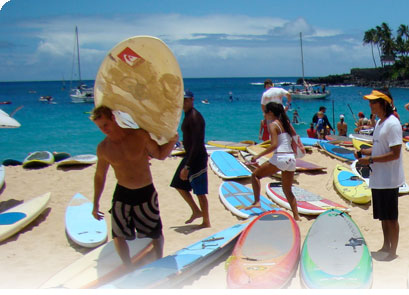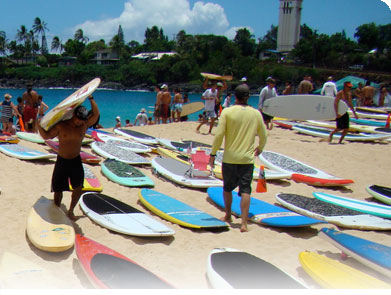above: Hui O He'e Nalu 4th of July Paddleboard Race at Waimea Bay
About The Author
Aloha my name is Gabriel Mizunaka. I am 16 years old and I live in Oahu Hawaii. I like to surf, slam poetry, rap, and dance hula and hip hop. I also have 2 triplet brothers that also surf and dance hula. I just started Stand up paddling and I love it.
Other Talk Story articles by Gabriel:
The Original Kings of Waikiki
The Ocean is not an Octagon |
 |
Talk Story
HISTORY OF A HAWAIIAN PATH-CARVER
By Gabriel Mizunaka
You know, it’s weird actually. I’ve learned about canoes, paddled a canoe, even helped rebuild and sail a canoe. But I’ve never really thought about the paddle (or hoe in Hawaiian). It’s something that never really stood out. But you can’t deny that it’s important to paddling.
The Hawaiian paddle was about 5 feet long with a long, round blade. Imagine paddling with a giant fan and you get the idea. This type of paddle was called the Hoe Nanue/Nenue, named after a large fish found in Hawaii. The Hoe Nenue was thought to be the only Hawaiian paddle until 1979. In a cave near Kiholo on the Big Island of Hawaii historians made a shocking discovery: a paddle that was long and thin with an oval blade, completely opposite to the Hoe Nenue. It is called the Hoe Kala (which means to remove or release), and is lighter and easier to paddle with than the Hoe Nenue. Historians debate on whether it was used for messenger canoes, races, or in battle.
Another interesting thing about the Hawaiian paddle is the Io, (or ‘Upe). The Io is a small bump or projection on the tip of the blade, about 2-3 inches long. Historians have tried to figure out what it was used for, but have no real answer. Some think it improved the hydrodynamics of the paddle, making paddling easier and faster. Others say it simply protected the blade when pushing off rocks or reef. I’m not a historian or a scientist, so I have no idea what the Io was for. But I know that the Ancient Hawaiians must have had a good reason to make their paddles that way
The Ancient Hawaiians loved to paddle. When the first Europeans arrived, they were astounded on how fast and quick the Ancient Hawaiians could paddle their canoes. One European even wrote “One Hawaiian in a canoe could paddle faster then an able-bodied crew in a whale boat.” Wow. One guy in a canoe could go faster then five or six guys in a boat. It seems almost impossible, but the Ancient Hawaiians could do that. Why? Because they loved it. They paddled almost everywhere they could. Sure they sailed, but only when it was absolutely necessary. Paddling was something they were good at, and they showed it to everyone. They even named the different ways that they paddled:
‘Akahoe - to paddle silently and carefully.
‘Awola -to paddle steadily, in time with others.
Haukawewe-to strike the paddle against the canoe. This was usually done in joy or to warn and enemy.
Panapana- to paddle irregularly.
Kahi malie- long easy strokes. Usually used when fishing.
The Hawaiian paddle has gone through a Rubik’s cube of identities over its life. For example, in 1888 King David Kalakaua published a book called the Myths and Legends of Hawaii, in which is a picture of a Hawaiian paddle with a t-shaped handle. However, the Tahitian paddle has a t-shaped handle, not the Hawaiian paddle.
Up to the early 1900s most of the paddles in Hawaii were shaped from one piece of wood, usually Koa or sometimes Milo. In the 1940s, a few beach boys like George Downing and Wally Froiseth began experimenting with paddle designs and sizes. Soon, paddles went from long and heavy to short and light. Instead of being made from one piece of wood, they were made from two or three separate pieces and attached together. Paddle blades slowly became shaped like pears and teardrops instead of just big ovals. Today’s contemporary paddles are around 3-4 feet long with narrow, thin blades, and can weigh 1½ -3 pounds. The Ancient Hawaiians used paddles nearly 3 times as heavy! But that’s probably because they made them from one piece of wood, whereas today’s paddles are often made of high-tech resins and carbon fiber.
I’ve always wondered what it would have been like if the Ancient Hawaiians didn’t enjoy paddling. How would it affect them? Would they travel less? Would they be less involved with the ocean? How would they go fishing, or send a message from island to island? Would there still be stories and Hawaiian chants about paddling?
I don’t know, but I do know that the paddle plays an important role in Hawaii’s history. It truly is a path-carver, for it’s helped Hawaiians carve trails in history. It’s helped Hawaiians find ways throughout the Pacific Ocean. And the Hawaiian paddle has helped carve the identity of the Hawaiian. It helped make them who they were, and who they are.
Bibliography:
History of Hawaiian Canoes-Tommy Holmes |

